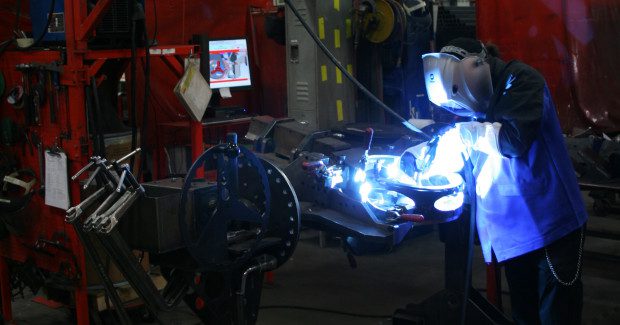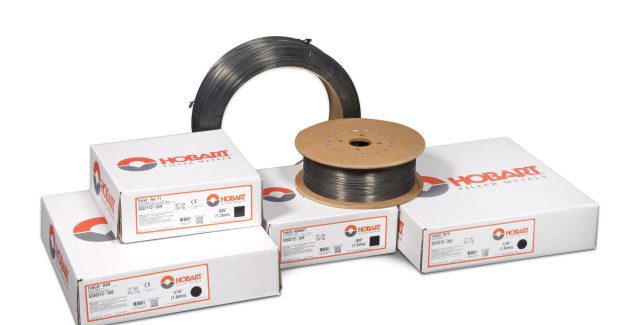Gaining Efficiencies by Increasing Welding Wire Size
The time and energy it takes to make the conversion from smaller-diameter wire to a larger one could save countless hours and improve quality. Here are several initial steps that are necessary to make the conversion.
Posted: September 3, 2015
More and more shops are looking for ways to streamline their welding operations and improve efficiencies. Some invest in advanced welding equipment, lean initiatives and/or improved welding operator training to get the job done. Taking a close look at the welding wire diameter being used is also beneficial. Many welding operations standardize on one size of wire for every application. Doing so helps minimize confusion for welding operators and helps avoid overcomplicating inventory and training. This standardization, however, can be problematic if the shop welds a wide range of applications that vary by material thickness or joint type.
Smaller welding wires are attractive because they require less heat input, provide an easy to-control the weld pool and have good gap bridging abilities. Still, they can slow down the welding operation by reducing deposition rates and travel speeds. They can also contribute to lack of fusion when welding on thicker materials. For these reasons shops may want to consider increasing the size of the wire diameter they are using — in the right application, it can save time and money in the long run. It is important to note that the actual deposition rates, travel speeds and overall efficiencies gained by sizing up the wires will depend on the specific diameter and type of wire used — for example, flux-cored, solid or metal-cored wires — along with the operating parameters and other variables in the welding operation. Weld properties can be found on the filler metal manufacturer’s website and in published literature (e.g., spec or data sheets).
IMPROVING EFFICIENCIES
It takes careful planning and oversight to manage an efficient welding operation, and no change should be made without cause or without an eye toward improvement. With that in mind, how do shops know when it’s time to make a switch to a larger diameter wire? There are two key signs.
First, the welding application is requiring higher and higher wire feed speeds to get the job done, or too high of a wire speed overall — both factors that waste filler metal and do not necessarily provide better weld quality or productivity. To determine if the wire feed speed is too high, consult the filler metal data sheet, which should include a sample welding parameters table. If the wire feed speed being used is higher than the manufacturer’s recommended maximum parameters, it may be time to consider at a larger diameter wire. Second, there is a desire to get more parts out the door and, in order to do so, the welding operation requires higher deposition rates and faster travel speeds — the two main advantages of using a larger sized wire.
THE CONVERSION PROCESS
Changing any variable in the welding process can often affect other aspects in the operation. In the case of converting to a larger wire diameter, it may be necessary to upgrade to a power source with larger output to help ensure good arc performance. While this upgrade requires a capital investment, the increases in throughput can often provide a relatively quick payback. Implementing welding operator training is also important so that employees know how to properly manage the arc and weld pool created by a larger diameter wire. Shops should be mindful of three main factors when converting to a larger diameter wire:
- Welding gaps. Larger diameter wires are typically less tolerant of poor joint fit-up and part variability. They also often have a greater tendency than smaller diameter wires to burn through thin materials. For the best results, look at other operations in the manufacturing process to handle large gaps and consider evaluating part stamping constancy to determine if it is necessary to make changes.
- Distortion. Switching to a larger diameter wire may change the heat input in the weld joint and distortion can result from it. It is an important issue to consider, but can often be compensated for by way of the joint design and/or weld procedure.
- Decreased out-of-position capabilities. Larger diameter wires equal a larger weld pool to control. This can present a greater challenge for welding operators, depending on the joint design and material thickness with which they are working.
The good news is that there are a few simple ways to address these potential issues and improve the overall quality of the welding operation in the process:
- Improve part tolerances: Look upstream in the welding operation, and when necessary, take steps to improve part tolerances for the best results.
- Alter welding parameters: Change the welding parameters for the welding operation accordingly — filler metal manufacturers provide the proper voltage, amperage and wire feed speed requirements for each welding wire. Always follows these recommendations. As mentioned previously, it may be necessary to use a higher output power source to achieve these new parameters. Also, pulsed MIG and other advanced welding processes can help decrease heat input, improve control of the weld puddle and improve out-of-position capabilities.
- Change welding procedures: Always review welding procedures before making a change to the welding process. When shops make significant changes in the welding process (such as converting to a different wire diameter), they may need to update and re-qualify welding procedures. Often, however, the productivity improvements will easily outweigh the effort and expense of having the procedures requalified.
Some shops may also want to consider converting from a solid wire to a larger diameter metal-cored wire to increase productivity and improve weld quality. Metal-cored wires are tubular wires containing an outer sheath filled with metal powders. These wires take less energy to melt than solid steel wires and provide a wider arc cone that results in better gap bridging. Shops can also increase deposition rates and travel speeds with these wires. Keep in mind that several initial steps are necessary to convert from a familiar smaller-diameter wire to a larger one. The time and energy it takes to make the conversion, however, could save countless hours and improve quality.
For more information about making the conversion, contact a trusted filler metal manufacturer or welding distributor. Also, for an app that helps shops select the amount of wire needed for applications, etc based on wire size, joint, etc., please click here.

















